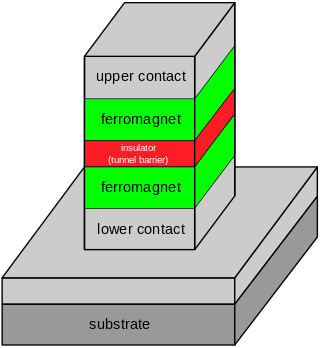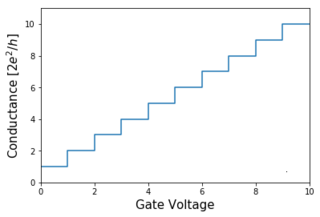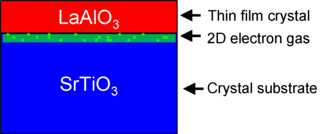Related Research Articles
Magnetoresistance is the tendency of a material to change the value of its electrical resistance in an externally-applied magnetic field. There are a variety of effects that can be called magnetoresistance. Some occur in bulk non-magnetic metals and semiconductors, such as geometrical magnetoresistance, Shubnikov–de Haas oscillations, or the common positive magnetoresistance in metals. Other effects occur in magnetic metals, such as negative magnetoresistance in ferromagnets or anisotropic magnetoresistance (AMR). Finally, in multicomponent or multilayer systems, giant magnetoresistance (GMR), tunnel magnetoresistance (TMR), colossal magnetoresistance (CMR), and extraordinary magnetoresistance (EMR) can be observed.
Spintronics, also known as spin electronics, is the study of the intrinsic spin of the electron and its associated magnetic moment, in addition to its fundamental electronic charge, in solid-state devices. The field of spintronics concerns spin-charge coupling in metallic systems; the analogous effects in insulators fall into the field of multiferroics.

Tunnel magnetoresistance (TMR) is a magnetoresistive effect that occurs in a magnetic tunnel junction (MTJ), which is a component consisting of two ferromagnets separated by a thin insulator. If the insulating layer is thin enough, electrons can tunnel from one ferromagnet into the other. Since this process is forbidden in classical physics, the tunnel magnetoresistance is a strictly quantum mechanical phenomenon.
Colossal magnetoresistance (CMR) is a property of some materials, mostly manganese-based perovskite oxides, that enables them to dramatically change their electrical resistance in the presence of a magnetic field. The magnetoresistance of conventional materials enables changes in resistance of up to 5%, but materials featuring CMR may demonstrate resistance changes by orders of magnitude.

Giant magnetoresistance (GMR) is a quantum mechanical magnetoresistance effect observed in multilayers composed of alternating ferromagnetic and non-magnetic conductive layers. The 2007 Nobel Prize in Physics was awarded to Albert Fert and Peter Grünberg for the discovery of GMR.

A magnon is a quasiparticle, a collective excitation of the spin structure of an electron in a crystal lattice. In the equivalent wave picture of quantum mechanics, a magnon can be viewed as a quantized spin wave. Magnons carry a fixed amount of energy and lattice momentum, and are spin-1, indicating they obey boson behavior.
Magnetic semiconductors are semiconductor materials that exhibit both ferromagnetism and useful semiconductor properties. If implemented in devices, these materials could provide a new type of control of conduction. Whereas traditional electronics are based on control of charge carriers, practical magnetic semiconductors would also allow control of quantum spin state. This would theoretically provide near-total spin polarization, which is an important property for spintronics applications, e.g. spin transistors.
Multiferroics are defined as materials that exhibit more than one of the primary ferroic properties in the same phase:
Exchange bias or exchange anisotropy occurs in bilayers of magnetic materials where the hard magnetization behavior of an antiferromagnetic thin film causes a shift in the soft magnetization curve of a ferromagnetic film. The exchange bias phenomenon is of tremendous utility in magnetic recording, where it is used to pin the state of the readback heads of hard disk drives at exactly their point of maximum sensitivity; hence the term "bias."

A quantum point contact (QPC) is a narrow constriction between two wide electrically conducting regions, of a width comparable to the electronic wavelength.
The spin Hall effect (SHE) is a transport phenomenon predicted by Russian physicists Mikhail I. Dyakonov and Vladimir I. Perel in 1971. It consists of the appearance of spin accumulation on the lateral surfaces of an electric current-carrying sample, the signs of the spin directions being opposite on the opposing boundaries. In a cylindrical wire, the current-induced surface spins will wind around the wire. When the current direction is reversed, the directions of spin orientation is also reversed.
A Josephson junction is a quantum mechanical device which is made of two superconducting electrodes separated by a barrier. A π Josephson junction is a Josephson junction in which the Josephson phase φ equals π in the ground state, i.e. when no external current or magnetic field is applied.
A half-metal is any substance that acts as a conductor to electrons of one spin orientation, but as an insulator or semiconductor to those of the opposite orientation. Although all half-metals are ferromagnetic, most ferromagnets are not half-metals. Many of the known examples of half-metals are oxides, sulfides, or Heusler alloys. Types of half-metallic compounds theoretically predicted so far include some Heusler alloys, such as Co2FeSi, NiMnSb, and PtMnSb; some Si-containing half–Heusler alloys with Curie temperatures over 600K, such as NiCrSi and PdCrSi; some transition-metal oxides, including rutile structured CrO2; some perovskites, such as LaMnO3 and SeMnO3; and a few more simply structured zincblende(ZB) compounds, including CrAs and superlattices. NiMnSb and CrO2 have been experimentally determined to be half-metals at very low temperatures.
Spin-polarized scanning tunneling microscopy (SP-STM) is a type of scanning tunneling microscope (STM) that can provide detailed information of magnetic phenomena on the single-atom scale additional to the atomic topography gained with STM. SP-STM opened a novel approach to static and dynamic magnetic processes as precise investigations of domain walls in ferromagnetic and antiferromagnetic systems, as well as thermal and current-induced switching of nanomagnetic particles.

Lanthanum strontium manganite (LSM or LSMO) is an oxide ceramic material with the general formula La1−xSrxMnO3, where x describes the doping level.
Ferromagnetic superconductors are materials that display intrinsic coexistence of ferromagnetism and superconductivity. They include UGe2, URhGe, and UCoGe. Evidence of ferromagnetic superconductivity was also reported for ZrZn2 in 2001, but later reports question these findings. These materials exhibit superconductivity in proximity to a magnetic quantum critical point.
In magnetism, a nanomagnet is a nanoscopic scale system that presents spontaneous magnetic order (magnetization) at zero applied magnetic field (remanence).
In quantum mechanics, orbital magnetization, Morb, refers to the magnetization induced by orbital motion of charged particles, usually electrons in solids. The term "orbital" distinguishes it from the contribution of spin degrees of freedom, Mspin, to the total magnetization. A nonzero orbital magnetization requires broken time-reversal symmetry, which can occur spontaneously in ferromagnetic and ferrimagnetic materials, or can be induced in a non-magnetic material by an applied magnetic field.

The interface between lanthanum aluminate (LaAlO3) and strontium titanate (SrTiO3) is a notable materials interface because it exhibits properties not found in its constituent materials. Individually, LaAlO3 and SrTiO3 are non-magnetic insulators, yet LaAlO3/SrTiO3 interfaces can exhibit electrical metallic conductivity, superconductivity, ferromagnetism, large negative in-plane magnetoresistance, and giant persistent photoconductivity. The study of how these properties emerge at the LaAlO3/SrTiO3 interface is a growing area of research in condensed matter physics.
Jacek K. Furdyna is a Polish American physicist and academic. He is a Professor Emeritus at the University of Notre Dame.
References
- ↑ Furdyna, J. K. (1988). "Diluted magnetic semiconductors". Journal of Applied Physics. 64 (4): R29–R64. Bibcode:1988JAP....64...29F. doi:10.1063/1.341700. S2CID 96287182. Archived from the original on 2013-02-23. Retrieved 2019-12-23.
- ↑ Ohno, H.; H. Munekata; T. Penney; S. von Molnár; L. L. Chang (1992-04-27). "Magnetotransport properties of p-type (In,Mn)As diluted magnetic III-V semiconductors". Physical Review Letters. 68 (17): 2664–2667. Bibcode:1992PhRvL..68.2664O. doi:10.1103/PhysRevLett.68.2664. PMID 10045456.
- ↑ Pinto, N.; L. Morresi; M. Ficcadenti; R. Murri; F. D'Orazio; F. Lucari; L. Boarino; G. Amato (2005-10-15). "Magnetic and electronic transport percolation in epitaxial Ge1−xMnx films". Physical Review B. 72 (16): 165203. arXiv: cond-mat/0509111 . Bibcode:2005PhRvB..72p5203P. doi:10.1103/PhysRevB.72.165203. S2CID 119477528.
- ↑ DeSimone, D.; C. E. C. Wood; Jr. Evans (July 1982). "Manganese incorporation behavior in molecular beam epitaxial gallium arsenide". Journal of Applied Physics. 53 (7): 4938–4942. Bibcode:1982JAP....53.4938D. doi:10.1063/1.331328. Archived from the original on 2013-02-23. Retrieved 2019-12-23.
- ↑ Munekata, H.; H. Ohno; S. von Molnar; Armin Segmüller; L. L. Chang; L. Esaki (1989-10-23). "Diluted magnetic III-V semiconductors". Physical Review Letters. 63 (17): 1849–1852. Bibcode:1989PhRvL..63.1849M. doi:10.1103/PhysRevLett.63.1849. PMID 10040689.
- 1 2 Ohno, H.; A. Shen; F. Matsukura; A. Oiwa; A. Endo; S. Katsumoto; Y. Iye (1996-07-15). "(Ga,Mn)As: A new diluted magnetic semiconductor based on GaAs". Applied Physics Letters. 69 (3): 363–365. Bibcode:1996ApPhL..69..363O. doi:10.1063/1.118061. Archived from the original on 2013-02-23. Retrieved 2019-12-23.
- 1 2 Ohno, H. (1998-08-14). "Making Nonmagnetic Semiconductors Ferromagnetic". Science. 281 (5379): 951–956. Bibcode:1998Sci...281..951O. doi:10.1126/science.281.5379.951. PMID 9703503.
- ↑ Yu, K. M.; W. Walukiewicz; T. Wojtowicz; I. Kuryliszyn; X. Liu; Y. Sasaki; J. K. Furdyna (2002-04-23). "Effect of the location of Mn sites in ferromagnetic Ga1−xMnxAs on its Curie temperature". Physical Review B. 65 (20): 201303. Bibcode:2002PhRvB..65t1303Y. doi:10.1103/PhysRevB.65.201303. S2CID 55483064.
- ↑ Grandidier, B.; J. P. Nys; C. Delerue; D. Stievenard; Y. Higo; M. Tanaka (2000-12-11). "Atomic-scale study of GaMnAs/GaAs layers". Applied Physics Letters. 77 (24): 4001–4003. Bibcode:2000ApPhL..77.4001G. doi:10.1063/1.1322052. Archived from the original on 2013-02-23. Retrieved 2019-12-23.
- ↑ Sadowski, J.; J. Z. Domagala (2004-02-19). "Influence of defects on the lattice constant of GaMnAs". Physical Review B. 69 (7): 075206. arXiv: cond-mat/0309033 . Bibcode:2004PhRvB..69g5206S. doi:10.1103/PhysRevB.69.075206. S2CID 118891611.
- ↑ Dietl, T.; H. Ohno; F. Matsukura; J. Cibert; D. Ferrand (2000-02-11). "Zener Model Description of Ferromagnetism in Zinc-Blende Magnetic Semiconductors". Science. 287 (5455): 1019–1022. Bibcode:2000Sci...287.1019D. doi:10.1126/science.287.5455.1019. PMID 10669409.
- ↑ Yu, K. M.; W. Walukiewicz; T. Wojtowicz; W. L. Lim; X. Liu; U. Bindley; M. Dobrowolska; J. K. Furdyna (2003-07-25). "Curie temperature limit in ferromagnetic Ga1−xMnxAs". Physical Review B. 68 (4): 041308. arXiv: cond-mat/0303217 . Bibcode:2003PhRvB..68d1308Y. doi:10.1103/PhysRevB.68.041308. S2CID 117990317.
- ↑ Edmonds, K. W.; K. Y. Wang; R. P. Campion; A. C. Neumann; N. R. S. Farley; B. L. Gallagher; C. T. Foxon (2002-12-23). "High-Curie-temperature Ga1−xMnxAs obtained by resistance-monitored annealing". Applied Physics Letters. 81 (26): 4991–4993. arXiv: cond-mat/0209554 . Bibcode:2002ApPhL..81.4991E. doi:10.1063/1.1529079. S2CID 117381870. Archived from the original on 2013-02-23. Retrieved 2019-12-23.
- ↑ Chiba, D.; K. Takamura; F. Matsukura; H. Ohno (2003-05-05). "Effect of low-temperature annealing on (Ga,Mn)As trilayer structures". Applied Physics Letters. 82 (18): 3020–3022. Bibcode:2003ApPhL..82.3020C. doi:10.1063/1.1571666. Archived from the original on 2013-02-23. Retrieved 2019-12-23.
- ↑ Ku, K. C.; Potashnik, S. J.; Wang, R. F.; Chun, S. H.; Schiffer, P.; Samarth, N.; Seong, M. J.; Mascarenhas, A.; Johnston-Halperin, E.; Myers, R. C.; Gossard, A. C.; Awschalom, D. D. (2003-04-07). "Highly enhanced Curie temperature in low-temperature annealed [Ga,Mn]As epilayers". Applied Physics Letters. 82 (14): 2302–2304. arXiv: cond-mat/0210426 . Bibcode:2003ApPhL..82.2302K. doi:10.1063/1.1564285. S2CID 119470957. Archived from the original on 2013-02-23. Retrieved 2019-12-23.
- ↑ Edmonds, K. W.; Boguslawski, P.; Wang, K. Y.; Campion, R. P.; Novikov, S. N.; Farley, N. R. S.; Gallagher, B. L.; Foxon, C. T.; Sawicki, M.; Dietl, T.; Buongiorno Nardelli, M.; Bernholc, J. (2004-01-23). "Mn Interstitial Diffusion in (Ga,Mn)As". Physical Review Letters. 92 (3): 037201–4. arXiv: cond-mat/0307140 . Bibcode:2004PhRvL..92c7201E. doi:10.1103/PhysRevLett.92.037201. PMID 14753901. S2CID 26218929.
- ↑ Wang, K. Y.; Campion, R. P.; Edmonds, K. W.; Sawicki, M.; Dietl, T.; Foxon, C. T.; Gallagher, B. L. (2005-06-30). "Magnetism in (Ga,Mn)As Thin Films With TC Up To 173K". Proceedings of the 27th International Conference on the Physics of Semiconductors. PHYSICS OF SEMICONDUCTORS: 27th International Conference on the Physics of Semiconductors – ICPS-27. Vol. 772. Flagstaff, Arizona (USA): AIP. pp. 333–334. arXiv: cond-mat/0411475 . doi:10.1063/1.1994124.
- ↑ Jungwirth, T.; Wang, K. Y.; Masek, J.; Edmonds, K. W.; Konig, Jurgen; Sinova, Jairo; Polini, M.; Goncharuk, N. A.; MacDonald, A. H.; Sawicki, M.; Rushforth, A. W.; Campion, R. P.; Zhao, L. X.; Foxon, C. T.; Gallagher, B. L. (2005-10-15). "Prospects for high temperature ferromagnetism in (Ga,Mn)As semiconductors". Physical Review B. 72 (16): 165204–13. arXiv: cond-mat/0505215 . Bibcode:2005PhRvB..72p5204J. doi:10.1103/PhysRevB.72.165204. hdl:1969.1/146812. S2CID 21715086.
- ↑ Matsumoto, Yuji; Makoto Murakami; Tomoji Shono; Tetsuya Hasegawa; Tomoteru Fukumura; Masashi Kawasaki; Parhat Ahmet; Toyohiro Chikyow; Shin-ya Koshihara; Hideomi Koinuma (2001-02-02). "Room-Temperature Ferromagnetism in Transparent Transition Metal-Doped Titanium Dioxide". Science. 291 (5505): 854–856. Bibcode:2001Sci...291..854M. doi: 10.1126/science.1056186 . PMID 11228146. S2CID 7529257.
- ↑ Reed, M. L.; N. A. El-Masry; H. H. Stadelmaier; M. K. Ritums; M. J. Reed; C. A. Parker; J. C. Roberts; S. M. Bedair (2001-11-19). "Room temperature ferromagnetic properties of (Ga, Mn)N". Applied Physics Letters. 79 (21): 3473–3475. Bibcode:2001ApPhL..79.3473R. doi:10.1063/1.1419231. Archived from the original on 2013-02-23.
- ↑ Han, S-J.; Song, J. W.; Yang, C.-H.; Park, S. H.; Park, J.-H.; Jeong, Y. H.; Rhie, K. W. (2002-11-25). "A key to room-temperature ferromagnetism in Fe-doped ZnO: Cu". Applied Physics Letters. 81 (22): 4212–4214. arXiv: cond-mat/0208399 . Bibcode:2002ApPhL..81.4212H. doi:10.1063/1.1525885. S2CID 119357913. Archived from the original on 2013-02-23.
- ↑ Saito, H.; V. Zayets; S. Yamagata; K. Ando (2003-05-20). "Room-Temperature Ferromagnetism in a II-VI Diluted Magnetic Semiconductor Zn1−xCrxTe". Physical Review Letters. 90 (20): 207202. Bibcode:2003PhRvL..90t7202S. doi:10.1103/PhysRevLett.90.207202. PMID 12785923.
- ↑ Sharma, Parmanand; Amita Gupta; K. V. Rao; Frank J. Owens; Renu Sharma; Rajeev Ahuja; J. M. Osorio Guillen; Borje Johansson; G. A. Gehring (October 2003). "Ferromagnetism above room temperature in bulk and transparent thin films of Mn-doped ZnO". Nature Materials. 2 (10): 673–677. Bibcode:2003NatMa...2..673S. doi:10.1038/nmat984. PMID 14502276. S2CID 13173710.
- ↑ Ohno, H.; D. Chiba; F. Matsukura; T. Omiya; E. Abe; T. Dietl; Y. Ohno; K. Ohtani (2000-12-01). "Electric-field control of ferromagnetism". Nature. 408 (6815): 944–946. Bibcode:2000Natur.408..944O. doi:10.1038/35050040. PMID 11140674. S2CID 4397543.
- ↑ Chiba, D.; M. Yamanouchi; F. Matsukura; H. Ohno (2003-08-15). "Electrical Manipulation of Magnetization Reversal in a Ferromagnetic Semiconductor". Science. 301 (5635): 943–945. Bibcode:2003Sci...301..943C. doi:10.1126/science.1086608. PMID 12855816. S2CID 29083264.
- ↑ Ohno, Y.; D. K. Young; B. Beschoten; F. Matsukura; H. Ohno; D. D. Awschalom (1999-12-16). "Electrical spin injection in a ferromagnetic semiconductor heterostructure". Nature. 402 (6763): 790–792. Bibcode:1999Natur.402..790O. doi:10.1038/45509. S2CID 4428472.
- ↑ Fukumura, T.; T. Shono; K. Inaba; T. Hasegawa; H. Koinuma; F. Matsukura; H. Ohno (May 2001). "Magnetic domain structure of a ferromagnetic semiconductor (Ga,Mn)As observed with scanning probe microscopes". Physica E. 10 (1–3): 135–138. Bibcode:2001PhyE...10..135F. doi:10.1016/S1386-9477(01)00068-6.
- ↑ Honolka, J.; S. Masmanidis; H. X. Tang; M. L. Roukes; D. D. Awschalom (2005-03-15). "Domain-wall dynamics at micropatterned constrictions in ferromagnetic (Ga,Mn)As epilayers". Journal of Applied Physics. 97 (6): 063903–063903–4. Bibcode:2005JAP....97f3903H. doi:10.1063/1.1861512. Archived from the original on 2013-02-23.
- ↑ Holleitner, A. W.; H. Knotz; R. C. Myers; A. C. Gossard; D. D. Awschalom (2005-05-15). "Manipulating a domain wall in (Ga,Mn)As". J. Appl. Phys. 97 (10): 10D314. Bibcode:2005JAP....97jD314H. doi:10.1063/1.1849055. Archived from the original on 2013-02-23. Retrieved 2019-12-23.
- ↑ Allwood, D. A.; G. Xiong; C. C. Faulkner; D. Atkinson; D. Petit; R. P. Cowburn (2005-09-09). "Magnetic Domain-Wall Logic". Science. 309 (5741): 1688–1692. Bibcode:2005Sci...309.1688A. doi:10.1126/science.1108813. PMID 16151002. S2CID 23385116.
- ↑ Chiba, D.; M. Yamanouchi; F. Matsukura; T. Dietl; H. Ohno (2006-03-10). "Domain-Wall Resistance in Ferromagnetic (Ga,Mn)As". Physical Review Letters. 96 (9): 096602. arXiv: cond-mat/0601464 . Bibcode:2006PhRvL..96i6602C. doi:10.1103/PhysRevLett.96.096602. PMID 16606291. S2CID 32575691.
- ↑ Tang, H. X.; S. Masmanidis; R. K. Kawakami; D. D. Awschalom; M. L. Roukes (2004). "Negative intrinsic resistivity of an individual domain wall in epitaxial (Ga,Mn)As microdevices". Nature. 431 (7004): 52–56. Bibcode:2004Natur.431...52T. doi:10.1038/nature02809. PMID 15343329. S2CID 4418295.
- 1 2 Ruster, C.; T. Borzenko; C. Gould; G. Schmidt; L. W. Molenkamp; X. Liu; T. J. Wojtowicz; J. K. Furdyna; Z. G. Yu; M. E. Flattý (2003-11-20). "Very Large Magnetoresistance in Lateral Ferromagnetic (Ga,Mn)As Wires with Nanoconstrictions". Physical Review Letters. 91 (21): 216602. arXiv: cond-mat/0308385 . Bibcode:2003PhRvL..91u6602R. doi:10.1103/PhysRevLett.91.216602. PMID 14683324. S2CID 13075466.
- ↑ Slonczewski, J. C. (June 1996). "Current-driven excitation of magnetic multilayers". Journal of Magnetism and Magnetic Materials. 159 (1–2): L1–L7. Bibcode:1996JMMM..159L...1S. doi:10.1016/0304-8853(96)00062-5.
- ↑ Yamanouchi, M.; D. Chiba; F. Matsukura; H. Ohno (2004-04-01). "Current-induced domain-wall switching in a ferromagnetic semiconductor structure". Nature. 428 (6982): 539–542. Bibcode:2004Natur.428..539Y. doi:10.1038/nature02441. PMID 15057826. S2CID 4345181.
- ↑ Chiba, D.; Y. Sato; T. Kita; F. Matsukura; H. Ohno (2004-11-18). "Current-Driven Magnetization Reversal in a Ferromagnetic Semiconductor (Ga,Mn)As/GaAs/(Ga,Mn)As Tunnel Junction". Physical Review Letters. 93 (21): 216602. arXiv: cond-mat/0403500 . Bibcode:2004PhRvL..93u6602C. doi:10.1103/PhysRevLett.93.216602. PMID 15601045. S2CID 10297317.
- ↑ Gould, C.; C. Ruster; T. Jungwirth; E. Girgis; G. M. Schott; R. Giraud; K. Brunner; G. Schmidt; L. W. Molenkamp (2004). "Tunneling Anisotropic Magnetoresistance: A Spin-Valve-Like Tunnel Magnetoresistance Using a Single Magnetic Layer". Physical Review Letters. 93 (11): 117203. arXiv: cond-mat/0407735 . Bibcode:2004PhRvL..93k7203G. doi:10.1103/PhysRevLett.93.117203. PMID 15447375. S2CID 222508.
- ↑ Giddings, A. D.; Khalid, M. N.; Jungwirth, T.; Wunderlich, J.; Yasin, S.; Campion, R. P.; Edmonds, K. W.; Sinova, J.; Ito, K.; Wang, K.-Y.; Williams, D.; Gallagher, B. L.; Foxon, C. T. (2005-04-01). "Large Tunneling Anisotropic Magnetoresistance in (Ga,Mn)As Nanoconstrictions". Physical Review Letters. 94 (12): 127202–4. arXiv: cond-mat/0409209 . Bibcode:2005PhRvL..94l7202G. doi:10.1103/PhysRevLett.94.127202. PMID 15903954. S2CID 119470467.